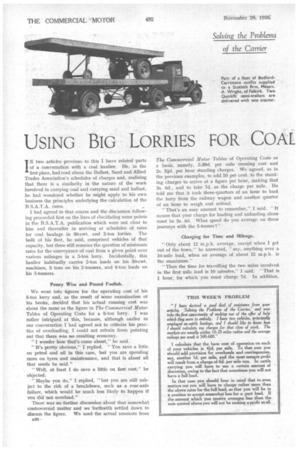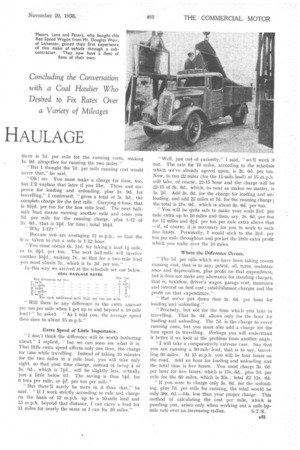USING BIG LORRIES FOR COAL
Page 44

Page 45

If you've noticed an error in this article please click here to report it so we can fix it.
H AULAGE Concluding the Conversation with a Coal Haulier, Who Desired to Fix Rates Over a Variety of Mileages /N two articles previous to this I have related parts of a conversation with a coal haulier. He, in the first place, had read about the Ballast, Sand and Allied Trades Association's schedules of charges and, realizing that there is a similarity in the nature of the work involved in carrying coal and carrying sand and ballast, he had wondered whether he might apply to his own business the principles underlying the calculation of the
I3.S.A.T.A. rates. .., I had agreed to that course and the discussion following proceeded first on the lines of elucidating some points in the B.S.A.T.A. publication which were not clear to him and thereafter in arriving at schedules of rates for coal haulage in 30-cwt. and 2-ton lorries. The bulk of his fleet, he said, comprised vehicles of that capacity, but there still remains the question of minimum rates for the conveyance of coal from a given point over various mileages in a 5-ton lorry. Incidentally, this haulier habitually carries 2-ton loads on his 30-cwt. machines, 3 tons on his 2-tonners, and 6-ton loads on his 5-tormers.
Penny Wise and Pound Foolish.
We went into figures for the operating cost of his 5-ton lorry and, as the result of some examination of his books, decided that his actual running cost was about the same as the figure in The Commercial Motor Tables of Operating Costs for a 6-ton lorry. I was rather intrigued at this, because, although earlier in our conversation I had agreed not to criticize his practice of overloading, I could not refrain from pointing out that there was no resulting economy.
"I wonder how that's come about," he said.
"Its pretty obvious," I replied. "You save a little on petrol and oil in this case, but you are spending' more on tyres and maintenance, and that is about all that needs be said."
"Well, at least I do save a little on first cost," he objected.
" Maybe you do," I replied, "but you are still subject to the risk of a breakdown, such as a rear-axle failure, which would be much less likely to happen if von did not overload." • There was no further discussion about that somewhat controversial matter and we 'forthwith settled down to• discuss the figure. We used the actual amounts from e30 The Commercial Motor Tables of Operating Costs as a basis, namely, 5.38d. per mile running cost and 2s. 34d. per hour standing charges. We agreed, as in the previous examples, to add 50 per cent. to the standing charges to arrive at a figure per hour, making that 3s. Gd., and to take 7d. as the charge per mile. He told me that it took three-quarters of an hour to load the lorry from the railway wagon and another quarter of an hour to weigh and unload.
"That's an easy amount to remember," I said. "It means that your charge for loading and unloading alone must be 3s. 6d. What speed do you average on these journeys with the 5-tormer?"
Charging for Time and Mileage.
" Only about 12 m.p.h. average, except when I get out of the town," he answered, " say, anything over a 10-mile lead, when an average of about 15 m.p.h. is the maximum." • " Then the time for travelling the two miles involved in the first mile lead is 10 minutes," I said. "That is hour, for which you must charge 7d. In addition,
there is 7d. per mile for the running costs, making Is. 9d. altogether for running the two miles."
'But I thought the 7d. per mile running cost would cover that," he said.
"Oh! no. You must make a charge for time, too, but I'll explain that later if you like. Three and sixpence for loading and unloading, plus Is. 9d. for travelling," I continued, " gives a total of 5s. 3d., the complete charge for the first mile. Carrying 6 tons, that is IOW. per ton fol.:the first mile lead. The next haltmile lead . means running another mile and costs you 7d. per mile for the running charge, plus 1-12 of 33. 6d., that is 30. for time ; total 104d.
"Why 1-12?"
" Because you are averaging 12 m.p.h., so that the ti lie taken to run a mile is 1-12 hour, "You must obtain 6.s. lid. for taking a load 1 mile, or is. aid. per ton. The next half-mile will involve another 100., making 7s., so that for a two-mile lead you must obtain 7s., which is 1s. 2d. per ton."
In this way we arrived at the schedule set out below.
"Will there be any difference in the extra amount per ton per mile when I get up to and beyond a 10-mile lead?" he asked. "As I told you, the average speed then rises to about 15 m.p.h."
Extra Speed of Little Importance.
"I don't think the difference will be worth bothering about," I replied, " but we can soon see what it is. That little extra speed affects only one item, the charge for time while travelling. Instead of taking 10 minutes for the two miles in a mile lead, you will take only eight, so that your time charge, instead of being of 3s. 6d., which is 71d., will be slightly less, actually just a little below 6d. The saving is thus lid. for 6 tons per mile, or Id. per ton per mile."
" But there'll surely be more in it than that," he said. "If I work strictly according to rule and charge on the basis of 12 m.p.h. up to a I0-mile lead and lc; m.p.h. bey' ond that distance, I can carry a load for 11 miles for nearly the same as I can fol. 10 miles." "Well, just out of curiosity," I said, "we'll work it out. The rate for 10 miles, according to the schedule which we've already agreed upon, is 3s. 6d. per ton. Now, to run 22 miles (for the 11-mile lead) at 15 m.p.h. will take, of course, 22-15 hour and the charge will be 22-15 of 3s. 6d., which, as near as makes no matter, is 5s. 2d. Add 3s. 6d. for the charge for loading and unloading, and add 22 miles at 7d. for the running charge; the total is 21s. 6d., which is about 3s. tid. per ton.
" You will be quite safe to make your scale 33/4d. per mile extra up to 10 miles and then, say, 3s. 6d. per ton for 11 miles and 314. per ton per mile extra above that -if, of course, it is necessary for you to work to such fine limits. PersOnally, I would stick to the 34d. per ton per mile throughout and pocket the little extra profit which you make dyer the 10 miles.
Where the Difference Occurs.
"The 7d. per Mile which we have been taking covers running cost, that is to say, petrol, oil, tyres, maintenance and depreciation, plus profit on that expenditure, but it does not make any allowance for standing charges, that is, taxation, driver's wages, garage rent, insurance and interest on first cost ; establishment charges and the profit on that expenditure."
"But we've put down that 3s. 6cl. per hour for loading 'and unloading."
"Precisely, but not for the time which you take in travelling. That 3s. 6d. allows only for the hour for loading and unloading. The 7d. is the charge to cover running costs, but you must also add a charge for the time spent in travelling. Perhaps you will understand it better if we look at the problem from another angle.
"I will take a comparatively extreme case. Say that you are running a 30-mile lead, that is to say, travelling 60 miles. At 15 m.p.h. you will be four hours on the road. Add an hour for loading and unloading and the total time is five hours. You must charge 3s. 6d. per hour for five hours, which is 17s. 6d., plus 7d. per mile for the 60 miles, which is 35s.: total 12s. 6d.
"If you were to charge only 3s. 6d. for the unlOading, plus 7d. per mile for running, the total would be only 38s. 6d.-14s. less than your proper charge. This method of calculating the cost per mile, which is puzzling you, arises only when working out a mile-by mile rate over an increasing radius. S.T.R.




























































































